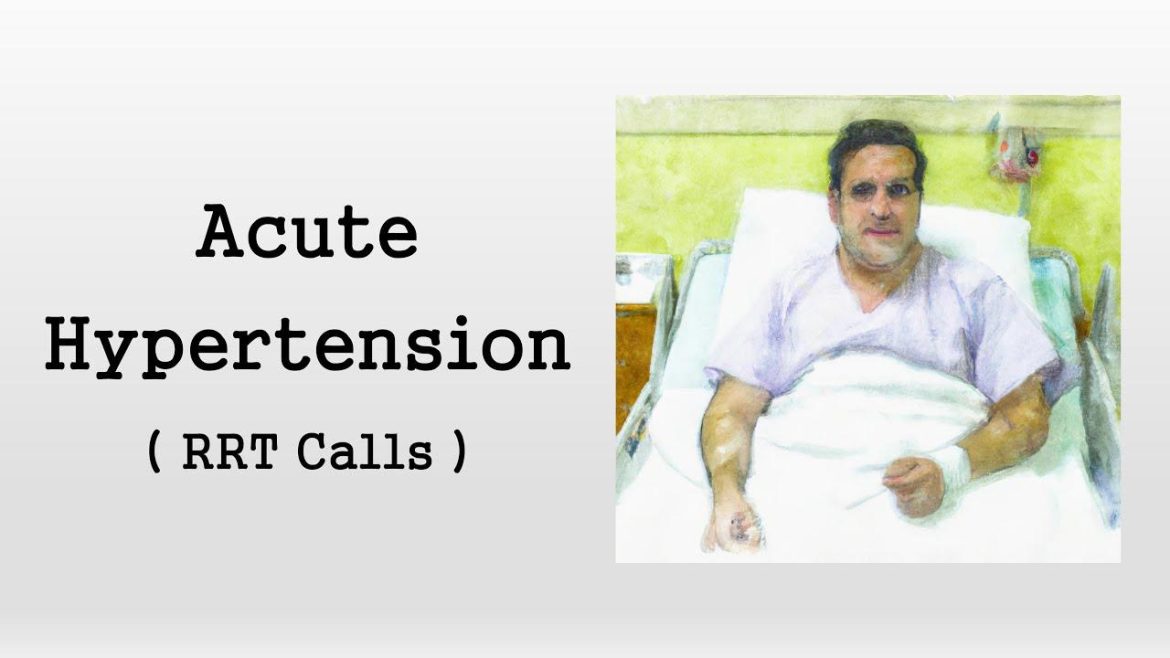Acute hypertension, also known as hypertensive crisis, is a severe increase in blood pressure that can lead to significant complications, including stroke, heart attack, and organ damage. This condition necessitates prompt medical intervention to prevent morbidity and mortality. Effective treatment of acute hypertension involves rapid assessment, immediate management, and appropriate long-term care strategies.
Understanding Acute Hypertension
Acute hypertension is typically classified into two categories: hypertensive urgency and hypertensive emergency.
Hypertensive Urgency
Hypertensive urgency is characterized by a marked elevation in blood pressure (usually >180/110 mm Hg) without evidence of target organ damage. Patients may present with symptoms such as severe headache, shortness of breath, and anxiety but do not exhibit acute end-organ dysfunction.
Hypertensive Emergency
Hypertensive emergency is a more critical condition where elevated blood pressure (>180/120 mm Hg) is associated with acute target organ damage, including encephalopathy, myocardial infarction, pulmonary edema, eclampsia, or acute renal failure. This requires immediate hospitalization and intensive care.
SEE ALSO: 5 Ways to Treat Essential Hypertension
Initial Assessment And Diagnosis
Clinical Evaluation
The initial assessment of a patient with acute hypertension involves a thorough clinical evaluation to identify symptoms, precipitating factors, and potential target organ damage. Key components of the evaluation include:
Detailed Medical History: Assessing previous blood pressure levels, medication adherence, and comorbid conditions.
Physical Examination: Measuring blood pressure in both arms, evaluating for signs of heart failure, neurologic deficits, and retinal hemorrhages or exudates.
Laboratory Tests: Basic metabolic panel, complete blood count, urinalysis, cardiac biomarkers, and renal function tests.
Imaging Studies: Chest X-ray, electrocardiogram (ECG), and, if indicated, computed tomography (CT) or magnetic resonance imaging (MRI) to evaluate for complications such as stroke or aortic dissection.
Immediate Management
Hypertensive Urgency
In hypertensive urgency, the goal is to gradually reduce blood pressure over 24-48 hours to prevent organ damage. This can typically be managed in an outpatient setting with oral antihypertensive medications.
Medications
Angiotensin-Converting Enzyme (ACE) Inhibitors: Captopril (initial dose: 25 mg orally).
Calcium Channel Blockers: Amlodipine (initial dose: 5 mg orally).
Beta-Blockers: Labetalol (initial dose: 100-200 mg orally).
Central Alpha Agonists: Clonidine (initial dose: 0.1-0.2 mg orally).
Hypertensive Emergency
Hypertensive emergency requires immediate hospitalization and continuous monitoring in an intensive care unit (ICU) setting. The primary objective is to rapidly but safely lower blood pressure to prevent further organ damage.
Intravenous Medications
Nitroprusside: Effective for rapid blood pressure control. Initial dose: 0.25-0.5 µg/kg/min IV infusion.
Labetalol: Useful for patients with myocardial ischemia or aortic dissection. Initial dose: 20 mg IV bolus, followed by continuous infusion.
Nicardipine: Preferred for neurological emergencies. Initial dose: 5 mg/h IV infusion.
Fenoldopam: A dopamine receptor agonist that improves renal perfusion. Initial dose: 0.1 µg/kg/min IV infusion.
Esmolol: Short-acting beta-blocker for rapid control. Initial dose: 500 µg/kg IV bolus, followed by infusion.
Treatment Targets
First Hour: Reduce mean arterial pressure (MAP) by no more than 25%.
Next 2-6 Hours: Achieve a target blood pressure of 160/100-110 mm Hg.
Next 24-48 Hours: Gradually normalize blood pressure based on patient stability.
Specific Clinical Scenarios
Acute Aortic Dissection
Rapid blood pressure control is critical. Target systolic BP <120 mm Hg within 20 minutes.
First-line Agents: Esmolol or labetalol to reduce shear stress.
Acute Pulmonary Edema
Reduction in preload and afterload is essential.
First-line Agents: Nitroglycerin or nitroprusside combined with diuretics.
Acute Myocardial Infarction
Blood pressure control to reduce myocardial oxygen demand.
First-line Agents: Beta-blockers (esmolol or metoprolol) and nitroglycerin.
Hypertensive Encephalopathy
Gradual reduction to prevent cerebral hypoperfusion.
First-line Agents: Nicardipine or labetalol.
Eclampsia or Severe Preeclampsia
Urgent blood pressure control to prevent seizures and further complications.
First-line Agents: Labetalol, hydralazine, or magnesium sulfate.
Long-term Management
Lifestyle Modifications
Diet: Low-sodium, DASH (Dietary Approaches to Stop Hypertension) diet.
Exercise: Regular physical activity (150 minutes of moderate exercise per week).
Weight Management: Achieving and maintaining a healthy weight.
Alcohol and Tobacco: Limiting alcohol intake and cessation of smoking.
Pharmacological Therapy
Long-term management typically involves the use of multiple antihypertensive agents to maintain target blood pressure.
Commonly Used Medications
ACE Inhibitors/ARBs: Lisinopril, losartan.
Calcium Channel Blockers: Amlodipine, diltiazem.
Thiazide Diuretics: Hydrochlorothiazide, chlorthalidone.
Beta-Blockers: Metoprolol, atenolol.
Monitoring and Follow-Up
Regular follow-up visits to monitor blood pressure, assess medication adherence, and evaluate for potential side effects are crucial.
Adjustments to the treatment regimen may be necessary based on the patient’s response and any emerging comorbid conditions.
Conclusion
The treatment of acute hypertension requires a comprehensive approach that includes rapid assessment, immediate blood pressure control, and long-term management strategies to prevent recurrence and complications. Early recognition and appropriate intervention can significantly improve outcomes for patients experiencing hypertensive crises. As healthcare providers, it is essential to stay updated on the latest guidelines and treatment protocols to effectively manage this potentially life-threatening condition.


